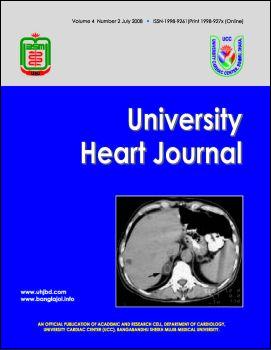Study of angiographic association of atherosclerotic renal artery stenosis with coronary artery disease in Bangladesh
DOI:
https://doi.org/10.3329/uhj.v4i2.2069Keywords:
ARASAbstract
This retrospective observational study aimed to see the angiographic association of atherosclerotic renal-artery stenosis (ARAS) with coronary artery disease in Bangladesh. It was conducted in department of cardiology, University Cardiac Centre, Bangabandhu Sheikh Mujib Medical University, Dhaka from January 2007 to January 2008. A total of 250 patients with coronary artery involvement, on non-emergent coronary angiogram who underwent either selective or nonselective renal angiography were enrolled in this study. Among 250 patients, 52 (20.8%) patient had single vessel disease (SVD), 49 (19.6%) and 149 (59.6%) had double vessel disease (DVD) and triple vessel disease (TVD) respectively. ARAS was detected in 37.2% or 93 patients. ARAS tends to increase with age. In age group of 30-40, ARAS is 7.4% whereas in age group of 51-60 years it is 41%. The incidence of ARAS is high in 50.25±9.98years; p=0.0001. 33.3% male patients with CAD had ARAS whereas it was 44.3% in female patients with CAD. ARAS is more common in female 44.3% vs 33.3%; p=0.02. ARAS prevalence increased with the number of stenosed coronary arteries (3.8% in 1-vessel, 26.5% in 2-vessel, 52.3%in 3-vessel CAD; p=.0001.). Hypertension and angiographically proven CAD were independent predictors of ARAS (p=0.0001). In conclusion, ARAS prevalence and severity increases with the number of arterial territories involved and CAD severity. Hypertension and 2-3-vessel-CAD were identified independent predictors of ARAS. Â
doi:10.3329/uhj.v4i2.2069
University Heart Journal Vol. 4 No. 2 July 2008 p24-27
Downloads
170
200

